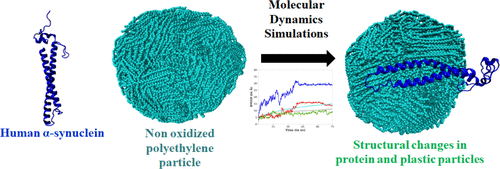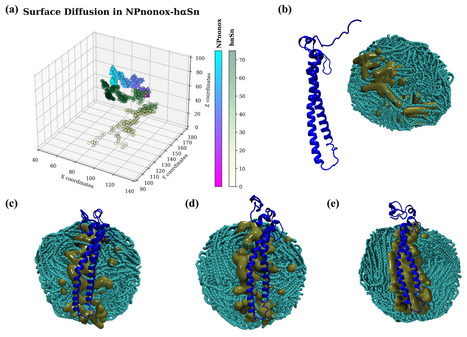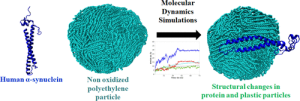Plastics are a major source of pollution. Their chemical stability has consequently become a major concern for the environment and health, due to their presence in all ecosystems. The penetration of plastic particles into living organisms through ingestion or inhalation has now been widely demonstrated. Micro- and nanoplastics are found throughout the human body, including in the brain, raising the question of their potential toxicity.

In a biological environment, a plastic particle does not remain isolated but interacts with surrounding molecules to form a “biocorona”, a layer of biomolecules that adsorb onto the particle’s surface. In a study published in Biomacromolecules, scientists from CEA Saclay (Laboratoires I2BC, NIMBE/LIONS and SRMP, CEA/UPSaclay, Gif-sur-Yvette) have assessed the binding behavior of human α-synuclein (hαSn), implicated in Parkinson’s disease, with polyethylene (PE)-based plastics using molecular dynamics simulations and experimental methods.
Simulations show that (a) hαSn folds into a compact conformation to enhance intramolecular interactions, (b) non-oxidized PE nanoplastics facilitate rapid adsorption of hαSn onto their surfaces with a change in the structural properties of hαSn, and (c) oxidized nanoplastics fail to capture hαSn. Experimental dynamic light scattering and adsorption isotherms are in good agreement with simulations.

Behavior of human α-synuclein (hαSn) on the surface of non-oxidized polyethylene (NPnonox) plastic particles. (a) Movement of the center of mass of hαSn (from yellow to green).
(b-e) adsorption and evolution of hαSn on the surface of NPnonox, as seen by nanosecond-scale molecular dynamics (MD): (b) 0 ns, (c) 25 ns, (d) 50 ns, and (e) 75 ns. Color code: hαSn in blue, and yellow-green for hαSn in contact with NPnonox (cyan).
The observed formation of the plastic nanoparticle complex with hαSn can be proposed as a plausible pathogenic driving force in neuronal dysfunction and subsequent neurological damage.
CEA contacts:
- CEA-IRAMIS: Jean-Philippe Renault UMR CEA_CNRS NIMBE/LIONS
- CEA-Joliot: Yves Boulard (I2BC)
References:
- Exploring the interaction of human α-synuclein with polyethylene nanoplastics: insights from computational modeling and experimental corroboration
Neha Tripathi, Florent Saudrais, Mona Rysak, Laura Pieri, Serge Pin, Guido Roma, Jean-Philippe Renault, Yves Boulard, Biomacromolecules 26(3) (2025) 1476–1497.
This publication was featured on the cover of Biomacromolecules.
See the highlight from the Joliot Institute: “Computational modeling reveals the nature of human alpha-synuclein interactions with polyethylene nanoplastics“.
Collaboration:
- NIMBE/LIONS – Nanosciences et Innovation pour les Matériaux, la Biomédecine et l’Énergie, UMR 3685 CEA-CNRS, Université Paris-Saclay.
- I2BC – Institut de Biologie Intégrative de la Cellule, UMR 9198 CEA-CNRS, Université Paris-Saclay.
- CEA –SC2M/SRMP, Section de Recherches de Métallurgie Physique, Université Paris-Saclay.


